The rest of the story.
Yesterday I posted a single (new) photo of the mated Red-tailed Hawks I photographed earlier this week and told readers I’d post more of them soon. With Feathered Photography the next day is about as soon as it gets, so here they are.
Prepare yourself. This is a long read.
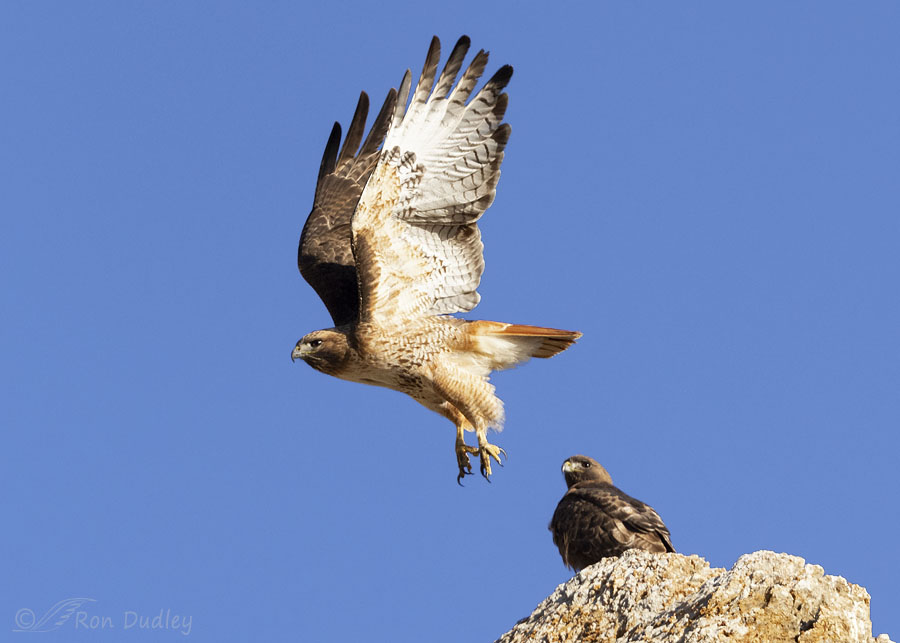
This photo of the mated pair is similar to, but different, than the one I posted yesterday. The male is the perched dark morph on the right and the female is in flight.
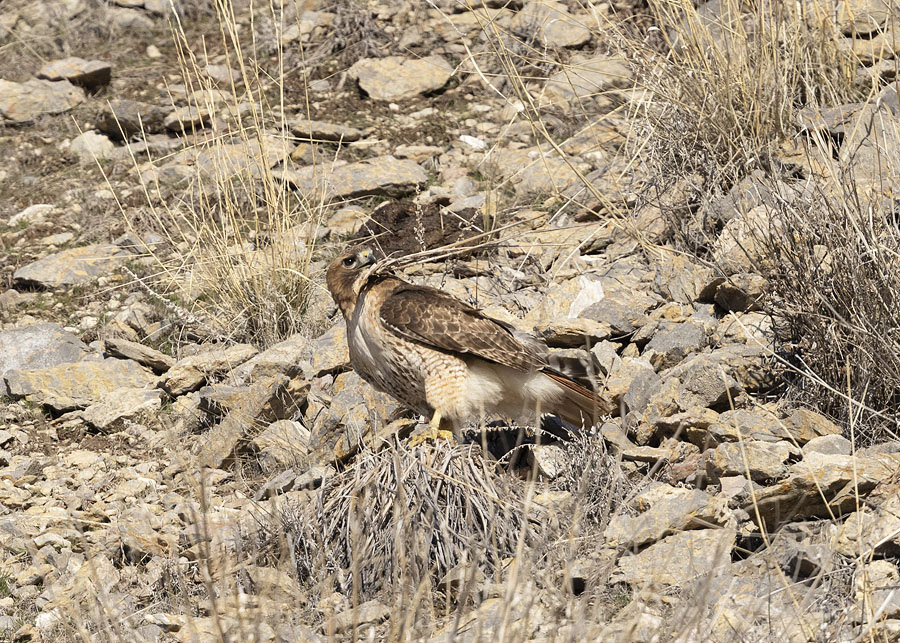
Both of them were gathering nesting material and taking it to their nest. This is the female with nesting material in her bill and looking up toward her nest, which is where she was about to go. In this habitat she’s so incredibly well camouflaged I had a devil of a time seeing her. If I looked away I usually couldn’t find her again.
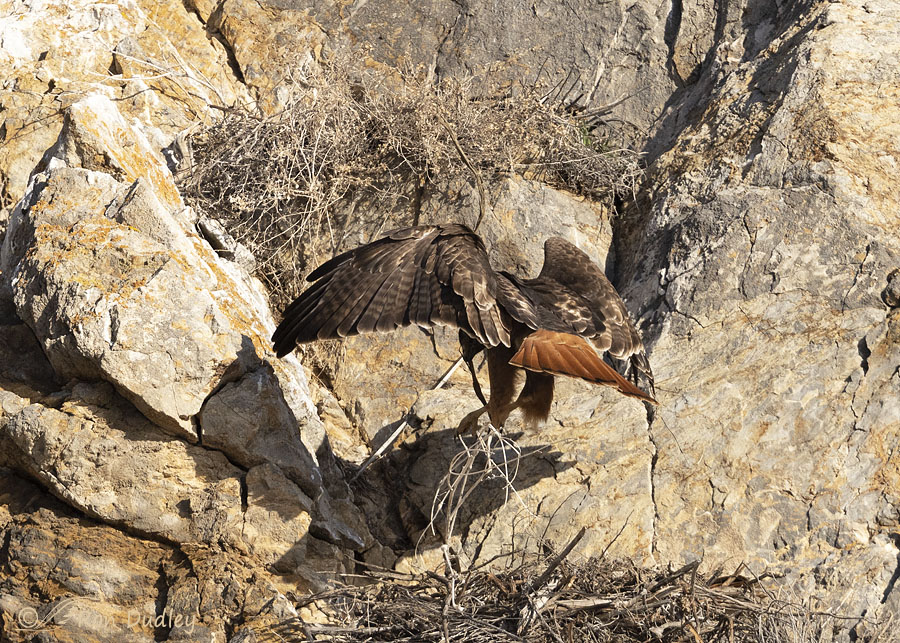
The nest is in a very difficult location for photography. As they approached it with nesting material they always had their backs to me. They had no choice.
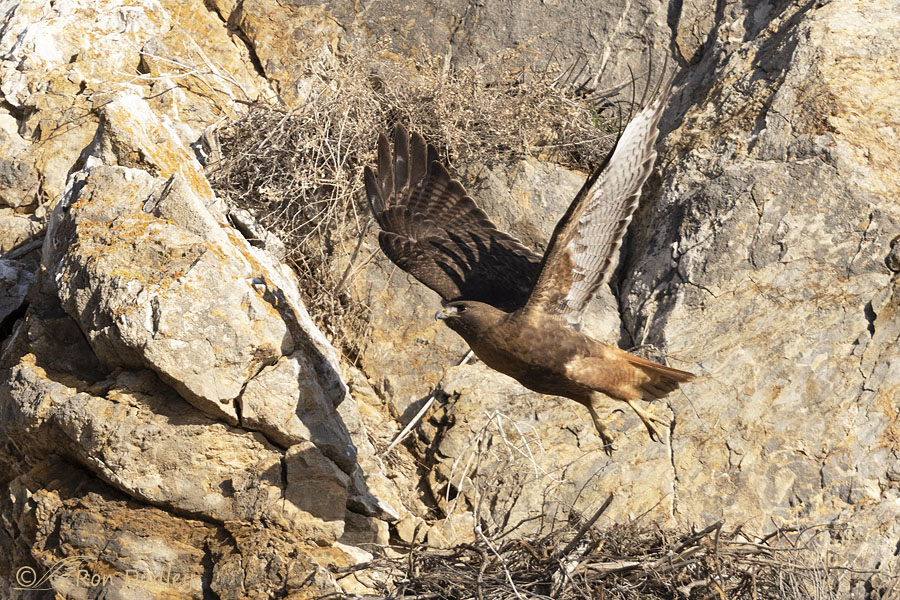
I had better luck when they took off from the nest to go look for more nesting material. This is the dark morph male.
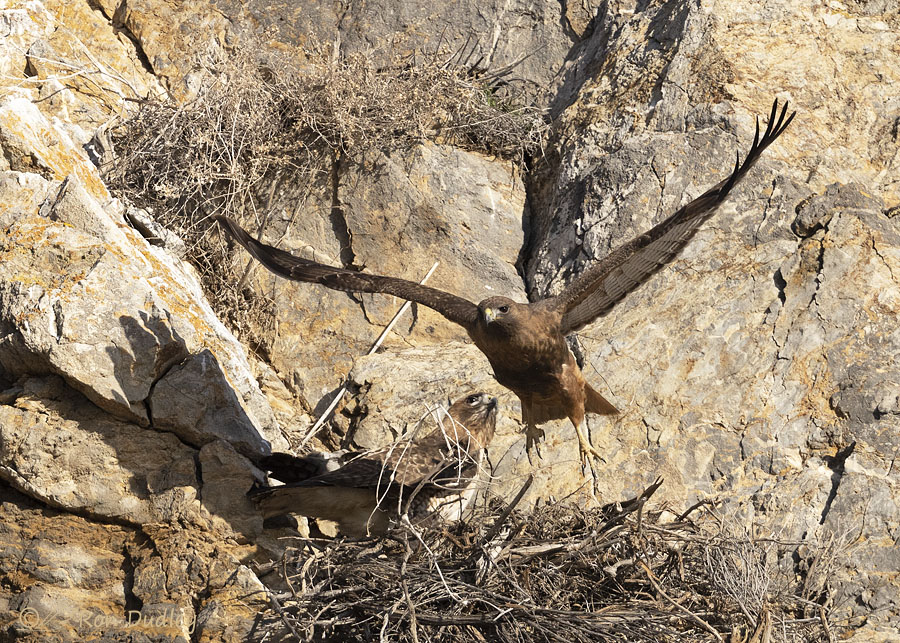
Occasionally they’d both be on the nest at the same time. Here the female in the background is watching her mate take off.
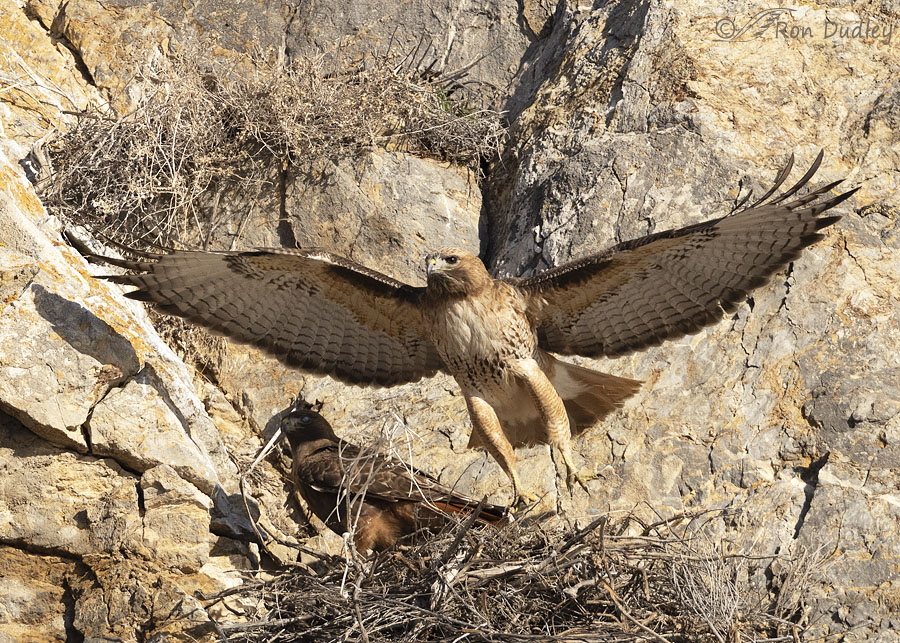
In this shot the roles are reversed.
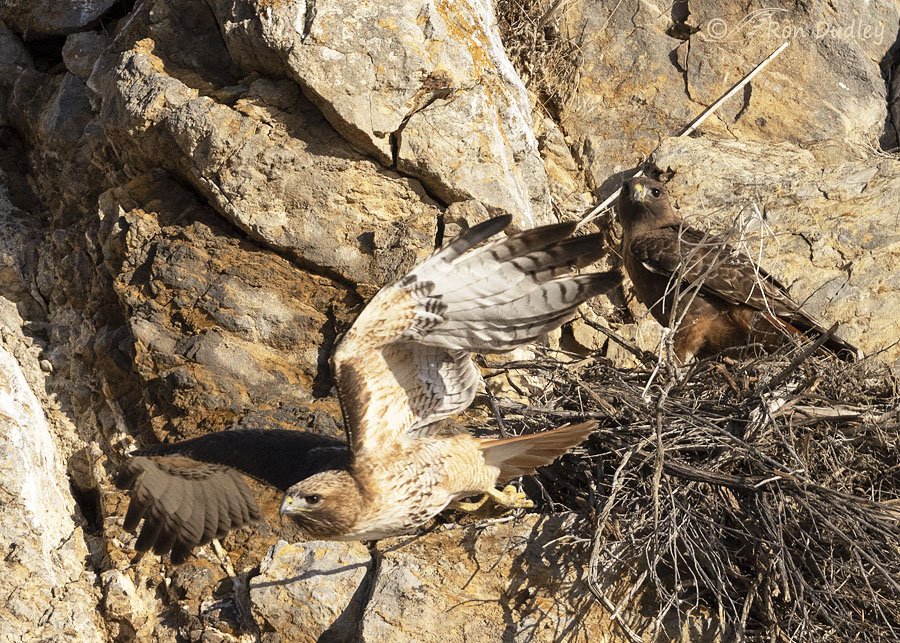
I was surprised, amazed really, by how much depth of field I had in this shot. Both birds are plenty sharp enough.
OK, some background for the following series of mating shots.
If I’ve learned anything about red-tail mating behavior over the years it’s that mating can often be predicted by watching their behavior, which is a huge advantage for the photographer who doesn’t want to miss the early shots of the performance. When I first started photographing birds, mating was often completed before I got my lens on them. These days that rarely happens to me. Here’s why.
In red-tails, the two birds are often far apart just prior to mating but two behaviors often occur just prior to the act and if you watch for them you can be prepared.
-
- The female may assume a “solicitation posture” by tilting forward until her body is nearly horizontal and fluttering her wings several times. Even though the male is typically some distance away, he’s watching for it and he doesn’t miss much. For the photographer, this is the least productive behavior of the two to watch for because it can be very difficult to notice when you’re trying to keep your eye on two birds that aren’t close to each other, or to you.
- But if you see the male take off and fly toward the female, get your lens on her immediately because, with no preliminaries at all, he’s likely to land directly on her back and initiate mating.
That’s exactly what happened with these two birds. The male and female were perched far apart but I kept my eye on the male to see if he’d take off and fly toward her. He did, almost on cue.
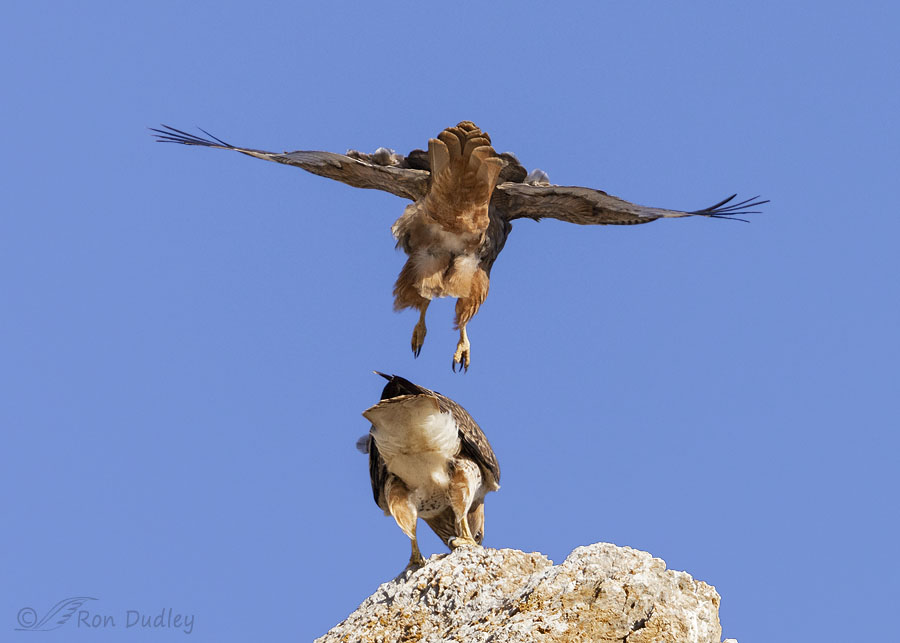
So I was able to get my lens on her before he even touched down on her back. Notice that she’s still in a solicitation posture with her head held low.
My first reaction to them having their backs to me during mating was disappointment but when I saw the photos I was actually delighted with them. I’ve photographed red-tail mating behavior from other angles quite a few times but this was the first time I’d had a ‘butt shot’ view of it.
Since mating is a butt-oriented behavior I appreciate the perspective.
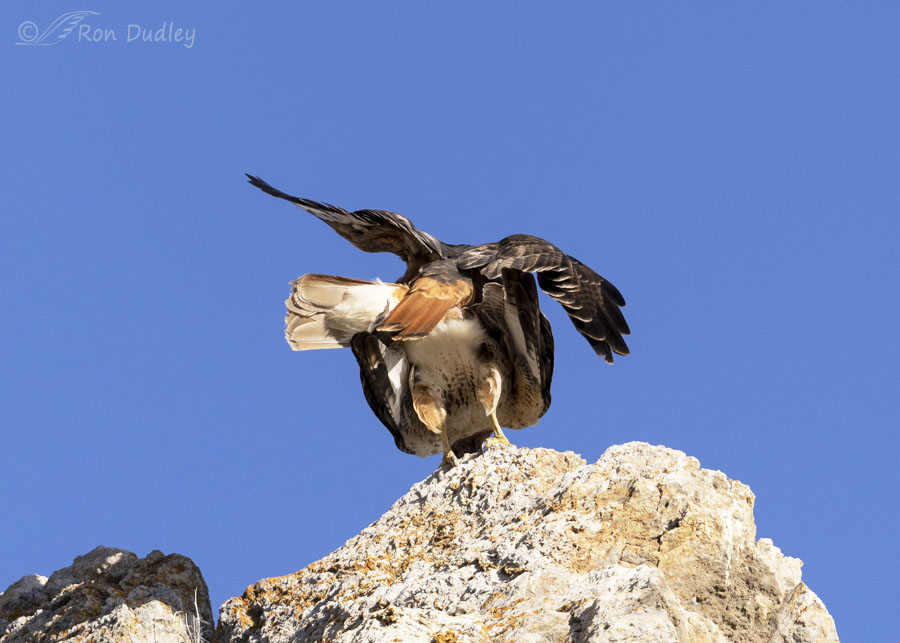
As is typical, the male struggled to maintain his balance on her back. The fact that the female was always leaning to her left didn’t help.
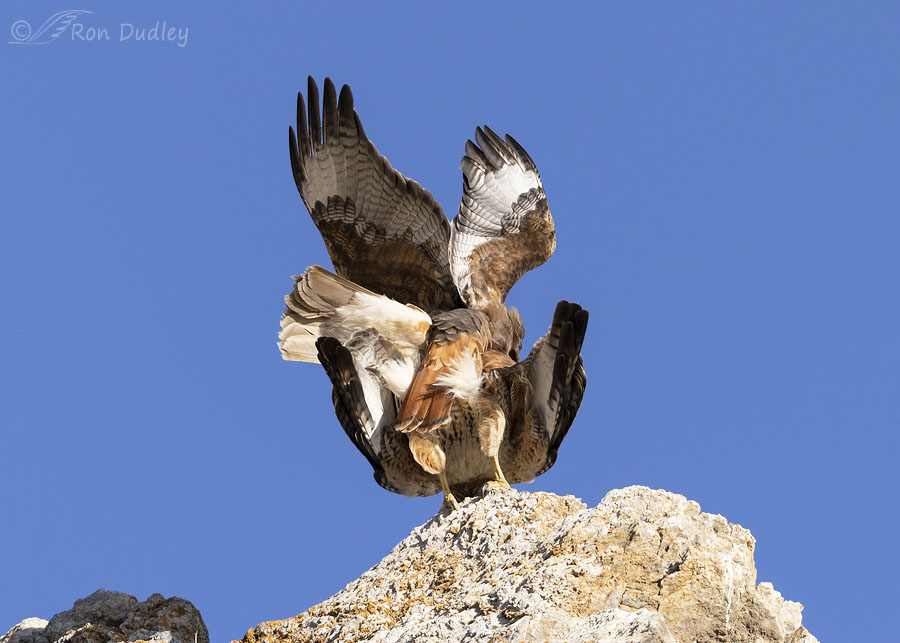
They have to touch cloacal openings (the “cloacal kiss”) to pass sperm between them and that’s quite a challenge, even though it only takes an instant when everything finally ‘comes together’.
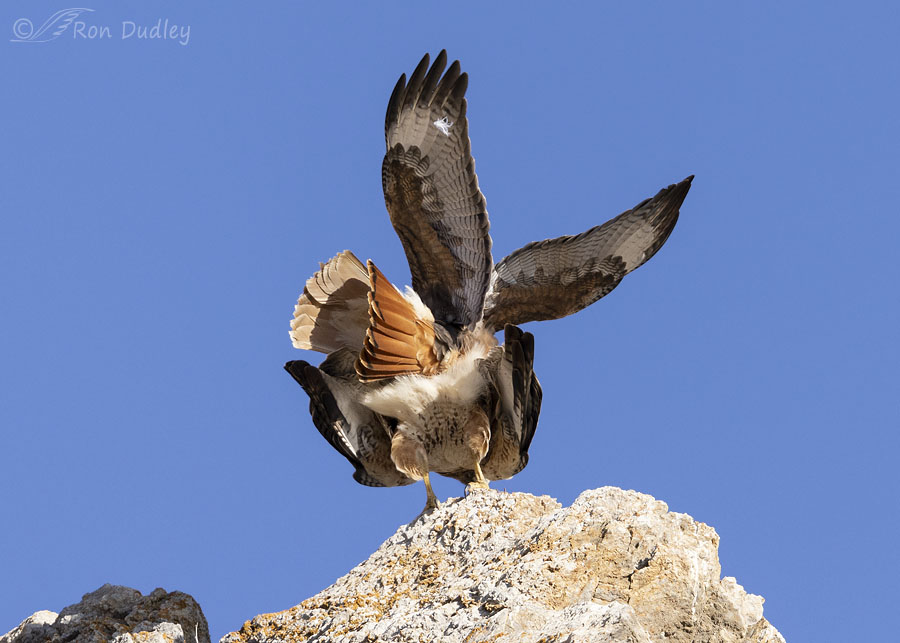
I believe this was about when it happened but it’s a little hard to tell for sure.
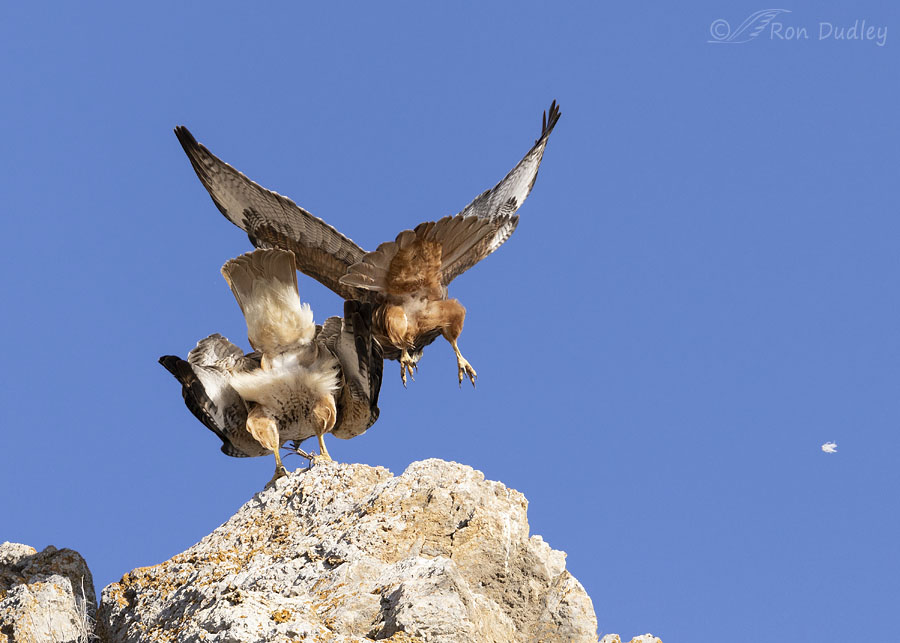
After the act was completed the male hopped off, with one of the birds losing a feather in the process. You can see that white feather in the previous photo too.
OK, at this point I’m going to digress for a moment. Sharp eyes may have noticed that the female has nesting material in her bill. I’ve never seen that happen with mating red-tails before. I don’t know if the male passed it to her after landing on her back (a “nuptial gift”) or she had it in her bill before he flew in. My guess is the latter.
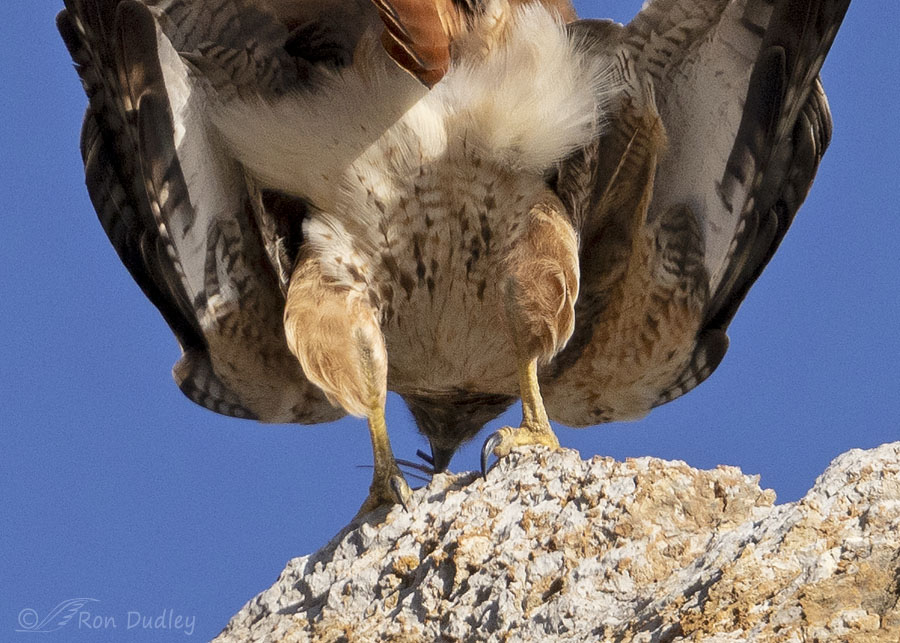
I was so surprised I looked through all 117 of my mating shots and this one was one of only two photos that confirmed that the nesting material was actually in her bill. With birds you just never know what you might see if you pay close attention.
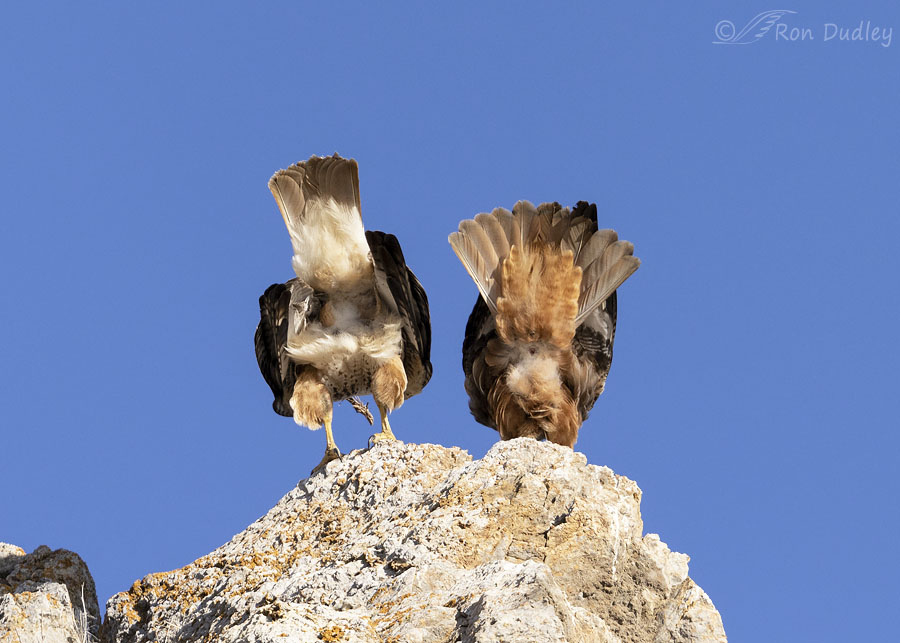
The end.
Ron
Note: I want to stress that these birds were never ever stressed by my presence. If they had been (and I know what to look for) I’d have left the area immediately. I was shooting from inside my pickup, on a road, with a super telephoto lens (500mm + 1.4 tc) and these photos have all been cropped significantly. Sorry, I don’t have time to provide image techs but I was using my usual gear, including the Canon R5.


That last photo of the Hawk Couple’s butt shots really sums it up doesn’t it? 😀 (Late comment I know)
I’ve read several of your mating red-tailed hawk posts and I’ve been meaning to ask, what kind of behavior do you look out for so you know you’re not disturbing them?
What a truly amazing series of photographs. I so look forward to your posts particularly the raptor ones. Thank you for sharing!
Nest building AND the “wedding night” all in one post — what a treat! Two really phenomenal series, Ron. You — and they — did not disappoint! The best part about this post is that for the little family’s safety I know you will never tell anyone where that nest is located. ❤️
“I know you will never tell anyone where that nest is located.”
It won’t come from me, Marty. You can count on it.
That’s an amazing series of photos, and your narrative provides a unique perspective. Thank you for sharing both.
Thank you, Quentin.
I’m very late to this Red-tail party but really glad to see all the festivities you so wonderfully captured! No such thing as a “long read” when it comes to such amazing photos and descriptions, making sure we understand what exactly is going on here. And how much effort for them to produce the hawklets we’re hoping to enjoy seeing in a few months (thanks to *your* efforts)!
Like Michael, my fav is #6 but the Grand Finale is the chef’s 💋!
And once again, someone’s post goes up while I’m still writing mine and when I post, I see I’ve said almost the identical thing. But I’m not plagiarizing, honest! Except I will second Carolyn’s comment that it’s good to see EC here again. ♥️
“the hawklets we’re hoping to enjoy seeing in a few months”
I’m hoping to document their progress, Chris. And in the end to report that they had unusual success this year – maybe even four youngsters fledged.
Ron – Very late to the party, but what a stupendous post! Each individual photo is amazing by itself – as a whole, really breath-taking! #5096, with those two tails forming that beautiful clamshell (“the moment?”), so beautiful! And of course, the last one – is that cigarette smoke wafting overhead? 💕
Lovely to see EC back, too.
“is that cigarette smoke wafting overhead?”
It’s the right mood for it, isn’t it Carolyn. Thank you.
Ron – am struggling for words. Just WOW WOW WOW!! Your capture of the two mating is a gift to bird lovers of the world – especially to us hawk lovers. Those butt shots are perfection. Wish my butt was that cute LOL!!
“Wish my butt was that cute”
They both have butts to die for, don’t they Kathleen.
Wow, wow and wow. What a post to come back to the blogosphere on. Thank you.
Thank you and welcome back, EC. Needless to say, you’ve been missed. And worried about.
Thank you. I am okish.
Ron, thanks for another great series! I love the photos and very much appreciate your comments about RTHA behavior prior to mating. With spring upon us I’ll be watching for these clues that I likely would’ve missed without your insights. Looking forward to seeing more of this nesting pair in the coming months!
“With spring upon us I’ll be watching for these clues”
Good to know, Julie. That’s exactly why I provided them. Good luck.
Hi Ron, having personally attempted to capture a Red-tailed Hawk mating sequence in the top of a Fir tree (far, far away from me) in NW Oregon two days ago, and looking at my resulting fuzzy pics on my computer that evening, I must offer high praise for your ability to capture this amazing mating ritual in such detail, with equally amazing clarity…wow, what a run-on sentence, ha.
Anyway, I continue to love your art!
Ha, I loved that sentence, Rick, run-on or not!
Day in, day out, you’re out in the field dealing with brutal cold, heat, rain, snow, and lack of cooperative birds or numbskull humans who scare them off. Then you go back home and pore over innumerable shots, looking for the best that will illustrate what you saw, and then you take the time to do a comprehensive write-up. Thanks so much for all your efforts to document behaviors and to educate your readers. It’s much appreciated.
And your comment is much appreciated, Linda. Thank you.
Catching up, I’ve been busy having fun exploring your stomping grounds in Great Falls. I love the series especially the double butt shot ending!
Glad you’re having fun in GF even if the weather hasn’t been the best! 🙂
It hasn’t been bad, chilly in the morning but sunny days. A bit early for birds but I am enjoying sight seeing and the people are so nice!
April, here’s a Great Falls story for you. True to the last detail.
In 1946 my parents (not yet my parents) went on their weeks-delayed honeymoon in Great Falls. The day they got there, while mom was getting her hair done, my dad bought a trunkful of chicks (baby chickens) and informed her that it was too hot for them in the trunk so they had to cancel their hotel reservations, and the rest of their honeymoon, and take the chicks back to the farm in Cut Bank. Which they did.
Mom was not pleased. I don’t believe I ever saw her smile when that story was told for the rest of her life. Dad didn’t either, but the rest of us sure did. We still do.
I imagine there were “repurcussions” for you dad from that, probably, good deal! XD
That shortcut for a laugh sure didn’t work…….. 🙁
The birds and nest blend in so well that I expect it would be very difficult to pick them out with or knowing where to look. Thanks for the laugh with the last photo. What a goodbye😁
It was difficult, Catherine. Thanks.
Great post. Thank you.
Thanks, Ann.
Great series, Ron! 🙂 I also thought the upper brush/whatever it is was the nest originally even if it looked pretty flimsy 😉 The action is definitely fast and furious (chickens are slower and more observable 😉 ) Without the “stop action” one wouldn’t really catch it. Definitely got a butt shot…..
Wonder if the back of the female takes a beating in the process?
“Wonder if the back of the female takes a beating in the process?”
With the male’s sharp talons and his struggle to stay on top of her, I would think so. Must be worth it though…:)
Never doubted that you were far from them Ron. I think we all are aware of your bird ethics and just assume you are in the truck far from them. What an outstanding series. Often amazed at your remarkable photography. Way back when you showed that one shot where you said how difficult it was for you to located them, looking at that I can sure understand that especially shooting from a long distance.
Laughing at the fact that she is standing slightly to the left side of the rock formation making for an unsteady position for him to come flying in and land on her back. But looks like they overcame all obstacles and got the job done.
“I think we all are aware of your bird ethics”
Everett, the problem is that a large number of the folks who see my posts are casual, sporadic visitors who are unaware of my field ethics. And some of them live for jumping on their high horse in public and berating photographers for supposed ethics violations. I try to head those folks off at the pass.
I have often quoted your motto regarding ethics and have turned down folks offers to scare birds off for me so I can get a take off photo etc – every photographer should be remembering those rules when out there seeking photos
Well done, Ron! A master’s class on RTHA nuptials all while sipping my coffee. Thank you!
Much appreciated, Diane.
Like Lyle, I had at first thought there were TWO nests in sight–like a natural
“bunkbed”…..the color in the male’s tail fan is gorgeous…..do dark morphs
customarily also have very deep red tail feathers, as well dark body feathers ?
“a natural “bunkbed”
Made me smile, Kris. That top “bunkbed” may be natural vegetation or an old nest. Or both.
Yes, if they’re adults dark morphs have red tails too.
Outstanding series! Thank you so much!
Thanks, Cindy.
Great series! I was not aware the “nuptial gift” was a thing birds did during mating. Glad to continue learning.
Brett, some birds do the “nuptial gift” thing but I’ve never heard of it being done by red-tails. Cornell’s Birds of the World doesn’t mention it either, not that I could find. It may not have happened here either.
Wow! Such a gift, Ron! Thank you so much, Ron!
You’re very welcome, Mary.
You have given us a real gift here. I’m quite sure this is a look into breeding activities I would otherwise never witness, especially from this angle.
At first I was puzzled that their nest looked rather flimsy until I realized it was not at the top of the frame but at the bottom.
The parting bow to the audience is a perfect “end” to the play.
“The parting bow to the audience is a perfect “end” to the play.”
Lyle, I thought so too. When I’m a witness to mating birds I always feel a bit like a voyeur, so maybe it was comeuppance I deserved.
Love this series of shots and explanation!
Thank you, Terri.
An amazing series of photos. Never seen so well documented. Photo #6 in my favorite. Thank you Ron.
Thanks, Michael. I’m glad you appreciate them.